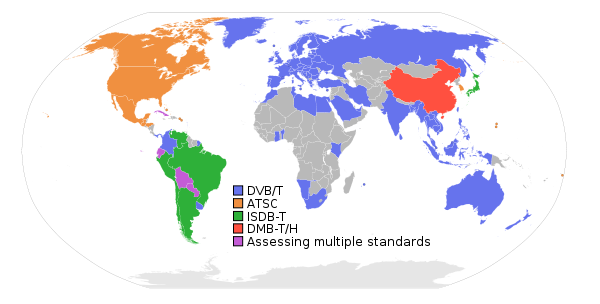DVB-T
DVB-T rationale
DVB-T (which stands for Digital Video Broadcasting — Terrestrial) is the DVB European-based consortium standard for the broadcast transmission of digital terrestrial television.
The specification is designed primarily for fixed reception to roof-top antennas and has frequency spectrum channel characteristics that are compatible with with Geneva 2006 Agreement. DVB-T has been published as an ETSI standard, EN 300 744. It is built on top of MPEG standards for aiudio/video coding and multiplexing, which are used according to the MPEG guidelines technical specification ETSI TS 101 154. Many countries that have adopted DVB-T have published specifications for its implementation. including the D-Book in the UK, the Italian DGTVi, the ETSI E-Book and Scandivia NorDig.
DVB-T has been further developed into newer standards such as DVB-H (Handheld), now in operation, and DVB-T2, which was recently finalised.
DVB-T baseline features
DVB-T transmits compressed digital audio, video and other data in an MPEG transport stream, using COFDM modulation. The transmission mechanism, which is based on data symbols, uses Multiple Carrier Frequencies. OFDM works by splitting the digital data stream into a large number of slower digital streams, each of which digitally modulate a set of closely spaced adjacent carrier frequencies. In the case of DVB-T, there are two choices for the number of carriers known as 2K-mode or 8K-mode. Within each frequency, DVB-T offers three different modulation schemes (QPSK, 16QAM and 64QAM) which choice is made depending on a robustness versus data rate compromise. The Guard Interval is the duration that allows to separate symbols in time in order to allow the receiver to handle a given amount of delay in the transmission path.
One of the main advantages of OFDM is that it allows the receiver to cope with strong multipath situations. DVB-T also allows single frequency networks (SFN) operation within a given geographical area, where two or more transmitters carrying the same data operate on the same frequency. In such cases the signals from each transmitter in the SFN needs to be accurately time-aligned, which is done by sync information in the stream and timing at each transmitter using the GPS timing reference. The Guard Interval length can be chosen according to a trade-off between data rate and SFN capability : the longer the guard interval, the larger the potential SFN area.
DVB-T adoption
Defined initially as a European norm, DVB-T has been adopted or proposed for digital television broadcasting by many countries throughout the world.

References:
– DVB website : http://www.dvb.org/technology/standards/
– Wikipedia : http://en.wikipedia.org/wiki/DVB-T
